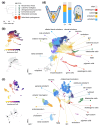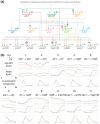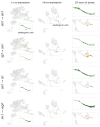Single-Cell Transcriptomics Reveals Evolutionary Reconfiguration of Embryonic Cell Fate Specification in the Sea Urchin Heliocidaris erythrogramma
- PMID: 39587400
- PMCID: PMC11719709
- DOI: 10.1093/gbe/evae258
Single-Cell Transcriptomics Reveals Evolutionary Reconfiguration of Embryonic Cell Fate Specification in the Sea Urchin Heliocidaris erythrogramma
Abstract
Altered regulatory interactions during development likely underlie a large fraction of phenotypic diversity within and between species, yet identifying specific evolutionary changes remains challenging. Analysis of single-cell developmental transcriptomes from multiple species provides a powerful framework for unbiased identification of evolutionary changes in developmental mechanisms. Here, we leverage a "natural experiment" in developmental evolution in sea urchins, where a major life history switch recently evolved in the lineage leading to Heliocidaris erythrogramma, precipitating extensive changes in early development. Comparative analyses of single-cell transcriptome analysis (scRNA-seq) developmental time courses from H. erythrogramma and Lytechinus variegatus (representing the derived and ancestral states, respectively) reveal numerous evolutionary changes in embryonic patterning. The earliest cell fate specification events and the primary signaling center are co-localized in the ancestral developmental gene regulatory network; remarkably, in H. erythrogramma, they are spatially and temporally separate. Fate specification and differentiation are delayed in most embryonic cell lineages, although in some cases, these processes are conserved or even accelerated. Comparative analysis of regulator-target gene co-expression is consistent with many specific interactions being preserved but delayed in H. erythrogramma, while some otherwise widely conserved interactions have likely been lost. Finally, specific patterning events are directly correlated with evolutionary changes in larval morphology, suggesting that they are directly tied to the life history shift. Together, these findings demonstrate that comparative scRNA-seq developmental time courses can reveal a diverse set of evolutionary changes in embryonic patterning and provide an efficient way to identify likely candidate regulatory interactions for subsequent experimental validation.
Keywords: cell fate specification; evolution of development; life history evolution; scRNA-seq; transcriptional regulation.
© The Author(s) 2024. Published by Oxford University Press on behalf of Society for Molecular Biology and Evolution.
Figures








Update of
-
Single-cell transcriptomics reveals evolutionary reconfiguration of embryonic cell fate specification in the sea urchin Heliocidaris erythrogramma.bioRxiv [Preprint]. 2024 May 1:2024.04.30.591752. doi: 10.1101/2024.04.30.591752. bioRxiv. 2024. Update in: Genome Biol Evol. 2025 Jan 6;17(1):evae258. doi: 10.1093/gbe/evae258. PMID: 38746376 Free PMC article. Updated. Preprint.
Similar articles
-
Single-cell transcriptomics reveals evolutionary reconfiguration of embryonic cell fate specification in the sea urchin Heliocidaris erythrogramma.bioRxiv [Preprint]. 2024 May 1:2024.04.30.591752. doi: 10.1101/2024.04.30.591752. bioRxiv. 2024. Update in: Genome Biol Evol. 2025 Jan 6;17(1):evae258. doi: 10.1093/gbe/evae258. PMID: 38746376 Free PMC article. Updated. Preprint.
-
Comparative Developmental Transcriptomics Reveals Rewiring of a Highly Conserved Gene Regulatory Network during a Major Life History Switch in the Sea Urchin Genus Heliocidaris.PLoS Biol. 2016 Mar 4;14(3):e1002391. doi: 10.1371/journal.pbio.1002391. eCollection 2016 Mar. PLoS Biol. 2016. PMID: 26943850 Free PMC article.
-
Recent reconfiguration of an ancient developmental gene regulatory network in Heliocidaris sea urchins.Nat Ecol Evol. 2022 Dec;6(12):1907-1920. doi: 10.1038/s41559-022-01906-9. Epub 2022 Oct 20. Nat Ecol Evol. 2022. PMID: 36266460
-
Experimentally based sea urchin gene regulatory network and the causal explanation of developmental phenomenology.Wiley Interdiscip Rev Syst Biol Med. 2009 Sep-Oct;1(2):237-246. doi: 10.1002/wsbm.24. Wiley Interdiscip Rev Syst Biol Med. 2009. PMID: 20228891 Free PMC article. Review.
-
Morphological evolution in sea urchin development: hybrids provide insights into the pace of evolution.Bioessays. 2004 Apr;26(4):343-7. doi: 10.1002/bies.20024. Bioessays. 2004. PMID: 15057932 Review.
Cited by
-
Applications of Spatial Transcriptomics in Veterinary Medicine: A Scoping Review of Research, Diagnostics, and Treatment Strategies.Int J Mol Sci. 2025 Jun 26;26(13):6163. doi: 10.3390/ijms26136163. Int J Mol Sci. 2025. PMID: 40649940 Free PMC article.
References
-
- Arshinoff BI, Cary GA, Karimi K, Foley S, Agalakov S, Delgado F, Lotay VS, Ku CJ, Pells TJ, Beatman TR, et al. Echinobase: leveraging an extant model organism database to build a knowledgebase supporting research on the genomics and biology of echinoderms. Nucleic Acids Res. 2022:50(D1):D970–D979. 10.1093/nar/gkab1005. - DOI - PMC - PubMed
MeSH terms
Grants and funding
LinkOut - more resources
Full Text Sources

